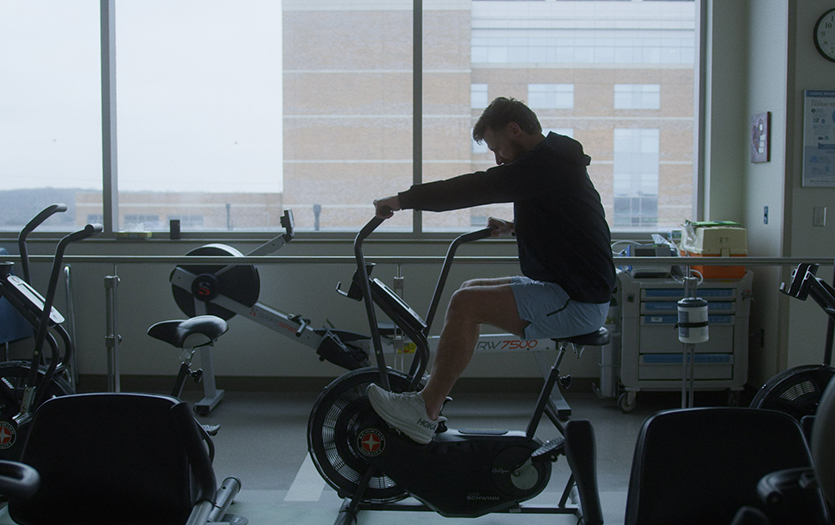A stroke is a medical emergency and treatment is time sensitive. Early detection and rapid treatment are critical to prevent long-term disability or, even, death. Two million brain cells die every minute in which a stroke goes untreated. The sooner one seeks medical treatment, the better the outcome. If you or someone close to you experiences a stroke, it is critical to immediately call 911 for medical care to begin as quickly as possible.
Parkview's stroke services begin when a patient arrives at one of our emergency departments for rapid evaluation and treatment. The treatment approach depends on a number of factors, including the type of stroke an individual experiences, personal health history and, perhaps most importantly, how quickly the individual seeks medical treatment.
Treatment options
There are two main types of stroke: ischemic and hemorrhagic. With an ischemic stroke, the blood flow in the artery within the brain has been blocked, often by a blood clot. A hemorrhagic stroke is caused by a rupture in a blood vessel in the brain. No matter what the type of stroke, the nationally recognized stroke team at the Parkview Stanley Wissman Stroke Center provides the highest level of stroke care for each patient.
Ischemic stroke
For this type of stroke, treatment focuses on restoring blood flow to the brain.
- You may get a clot-dissolving medication, called a thrombolytic agent, to improve recovery from a stroke, especially when possible to administer it within three hours after stroke symptoms begin. In some cases, individuals still benefit from medication if they receive this medication even up to 4½ hours of their first symptoms.
- You may also get aspirin or another antiplatelet medication.
- In some cases, a procedure called a thrombectomy may be performed to restore blood flow. The procedure involves use of a thin, flexible tube (a catheter) and a tiny device to remove the blood clot that caused the stroke.
Hemorrhagic stroke
For this type of stroke, treatment focuses on controlling bleeding, reducing pressure in the brain, and stabilizing vital signs, especially blood pressure.
- To stop the bleeding, you may receive medication or a transfusion of plasma, a component of blood, through an IV. You will be closely watched for signs of increased pressure on the brain. These signs include restlessness, confusion, trouble following commands, and headache. Other measures will be taken to keep you from straining from excessive coughing, vomiting, or lifting, or straining to pass stool or change position.
- If the bleeding is from a ruptured brain aneurysm, surgery to repair the aneurysm may be done.
- In some cases, medication may be given to control blood pressure, brain swelling, blood sugar levels, fever, and seizures.
- If a large amount of bleeding has occurred and symptoms are worsening, you may need surgery. The surgery can remove the blood that has built up inside the brain and lower pressure inside the head.
After either kind of stroke and after your condition is stable, treatment shifts to preventing future strokes and other conditions that may affect your recovery.
What makes Parkview stroke services unique?
Parkview’s stroke team utilize advanced medical technology and treatments that offer individuals the best opportunities for recovery.
Advanced medical technology
Parkview adopted RapidAI technology for use in all Parkview-affiliated hospitals. This advanced system rapidly detects a possible stroke and immediately alerts the medical team to help speed up time-critical evaluation of a patient or transfer decisions and facilitate better patient outcomes.
In 2020, the stroke center at Parkview Regional Medical Center opened a dedicated neurointerventional lab with state-of-the-art equipment, such as the bi-plane imaging system, This system provides high-definition images of the brain, allowing for precise location and extraction of a blood clot, which is often the source of a stroke.
Clinical expertise and treatment
The stroke center at Parkview Regional Medical Center, a comprehensive stroke center, is supported by neurointerventional physicians who are specially trained in procedures to treat stroke. One such procedure for ischemic strokes involves the use of a small tube, called a catheter, that is inserted into an artery in the leg and then guided into the brain. Through this catheter, the clot-busting medication tPA can be delivered directly at the site of the clot or a device can be used to remove the clot. For hemorrhagic strokes, specifically subarachnoid hemorrhages (SAH) caused by aneurysms, treatment again uses a catheter inserted into an artery in the leg and guided into the brain. Through this catheter, special thin wires are inserted into the aneurysm. The wires then “coil” up to block the blood flow effectively removing the risk of the aneurysm to bleed. These procedures can halt a stroke in process.
Surgical stroke treatment
In the event of a hemorrhagic stroke, the stroke team at Parkview Regional Medical Center has neurosurgical expertise to provide advanced surgical stroke treatment. Our highly skilled neurosurgeons offer a specialized skill sets to treat a wide range of complex medical emergencies, including aneurysm clippings and procedures to remove accumulated blood that may have settled on the brain. Aneurysm clippings involve the physician surgically securing a metal clip at the bottom of the aneurysm to prevent the aneurysm from bleeding. Sometimes too much blood accumulates in the brain and the neurosurgeon must surgically remove the excess blood, known as a hematoma evacuation.
Access to advanced stroke treatment options at Parkview delivered by highly skilled physicians and care teams allows patients with complex conditions to receive the highest-level of stroke treatment.



